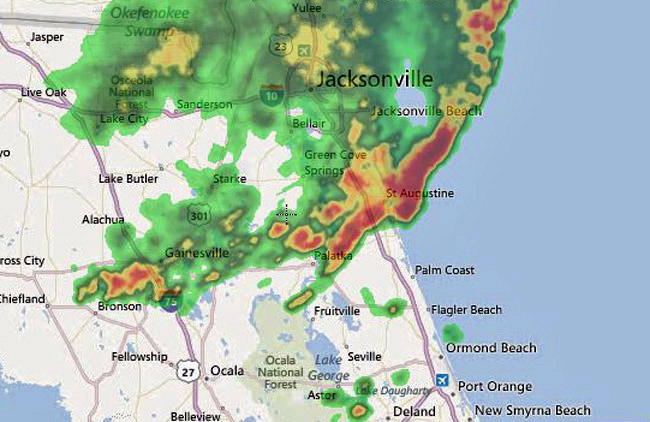
Last Updated: 5:10 p.m.
5 p.m. Update: The National Wearther Service has downgraded the thunderstorm warning to a significant weather advisory until 5:30 p.m.
4:30 p.m.: The National Weather Service has issued a severe thunderstorm warning for northern Flagler County as well as northeastern Putnam and southeastern St. Johns counties until 5 p.m. Tuesday.
A band of severe thunderstorms was moving across northeast Florida and southeast Georgia after 4 p.m., producing damaging winds in excess of 60 miles per hour. The storm was moving east at 10 mph.
St. Augustine, Marineland, Crescent Beach and Butler Beach are also included in the warning.
![]()
When Dangerous Weather Approaches: Avoid the Lightning Threat
■ Have a lightning safety plan. Know where you’ll go for safety and how much time it will take to get there. Make sure your plan allows enough time to reach safety.
■ Postpone activities. Before going outdoors, check the forecast for thunderstorms. Consider postponing activities to avoid being caught in a dangerous situation.
■ Monitor the weather. Look for signs of a developing thunderstorm such as darkening skies, flashes of lightning, or increasing wind.
■ Get to a safe place. If you hear thunder, even a distant rumble, immediately move to a safe place. When Thunder Roars, Go Indoors! Fully enclosed buildings with wiring and plumbing provide the best protection. Sheds, picnic shelters, tents or covered porches do not protect you from lightning. If a sturdy building is not nearby, get into a hard-topped metal vehicle and close all the windows. Stay inside until 30 minutes after the last rumble of thunder.
■ If you hear thunder, don’t use a corded phone. Cordless phones, cell phones and other wireless handheld devices are safe to use.
■ Keep away from electrical equipment, wiring and water pipes. Sensitive electronics should be unplugged well in advance of thunderstorms. Don’t take a bath, shower or use other plumbing during a thunderstorm.
When Caught Outside During Thunder
There is no safe place outside during a thunderstorm. Plan ahead to avoid this dangerous situation! If you’re outside and hear thunder, the only way to significantly reduce your risk of becoming a lightning casualty is to get inside a substantial building or hard-topped metal vehicle as fast as you can. Remember, there is no substitute for getting to a safe place.
■ Avoid open areas and stay away from isolated tall trees, towers, or utility poles. Do not be the tallest object in the area. Lightning tends to strike the tallest objects in the area.
■ Stay away from metal conductors such as wires or fences. Metal does not attract lightning, but lightning can travel long distances through it.
Remember, if you can hear thunder – you are close enough to be struck by lightning. For more information on lightning safety, go here.
–NOAA





























Leave a Reply